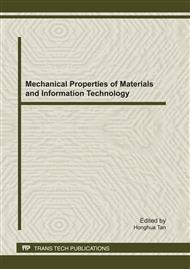[1]
H. M. Brown, Mode of action, crop selectivity and soil relations of sulfonylurea herbicides, Pesticide Science, Vol. 29, p.263–281, (1990).
DOI: 10.1002/ps.2780290304
Google Scholar
[2]
S. S. Pang, C.W. Cuddat, R. G. Dugggleby, Crystallization of Arabidopsis thaliana acetohydroxyacid synthase in complex with the sulfonylurea herbicide chlorimuron-ethyl, , Acta cryst, Vol. 60, pp.153-155, (2004).
DOI: 10.1107/s0907444903025423
Google Scholar
[3]
I. M. Head, Bioremediation : towards a credible technology, , Microbiology, Vol. 144, pp.599-608, (1998).
DOI: 10.1099/00221287-144-3-599
Google Scholar
[4]
B. M. Berger, K. Janowitz, H. J. Menne, H. H. Hoppe, Comparative study on microbial and chemical transformation of eleven sulfonylurea herbicides in soil, Zeitschrift für Pflanzenkrankheiten und Pflanzenschutz, vol. 105, no. 6, pp.611-623, (1998).
Google Scholar
[5]
M. Alexander, Biodegradation of chemicals of environmental concern, , Science Vol. 211, no. 4778, p.132–138, January (1981).
Google Scholar
[6]
X. Pu, T. J. Outright, Degradation of pentachlorophenol by pure and mixed cultures in two different soils, Environmental Science and Pollution Research, Vol. 14, no. 4, pp.244-250. (2007).
DOI: 10.1065/espr2006.07.321
Google Scholar
[7]
J. Xu, M. Yang, J. Y. Dai, H. Cao, C. P. Pan, X. H. Qiu, M. Q. Xu, Degradation of acetochlor by four microbial communities, Bioresource Technology , vol. 99, no. 16, p.7797–7802, November (2008).
DOI: 10.1016/j.biortech.2008.01.060
Google Scholar
[8]
J. P. Ma, Z. Wang, P. Lu, H. J. Wang, S. W. Ali, S. P. Li, X. Huang, Biodegradation of the sulfonylurea herbicide chlorimuron-ethyl by the strain Pseudomonas sp. LW3, FEMS Microbiol Lett, Vol. 296, p.203–209, (2009).
DOI: 10.1111/j.1574-6968.2009.01638.x
Google Scholar
[9]
N. Sanyal, S. K. Pramanik, R. Pal, A. Chowdhury, Laboratory simulated dissipation of metsulfuron methyl and chlorimuron ethyl in soils and their residual fate in rice, wheat and soybean at harvest, Journal of Zhejiang University, Vol. 7, no. 3, pp.202-208, (2006).
DOI: 10.1631/jzus.2006.b0202
Google Scholar
[10]
Y. N. Guo, T. Zhao, Z. Tong, R, S, Tian, Study on combination and ultraviolet mutation of PVA-degrading strains, Chinese Journal of Environmental Engineering, Vol. 4, No. 7, pp.1669-1674, July (2010).
Google Scholar
[11]
J. L. Chen, K. C. Au, Y. S. Wong, N. F. Yee Tam, Using orthogonal design to determine optimal conditions for biodegradation of phenanthrene in mangrove sediment slurry, Journal of Hazardous Materials, Vol. 176, p.666–671, (2010).
DOI: 10.1016/j.jhazmat.2009.11.083
Google Scholar
[12]
J.X. Wang, X. H Zhang, W.H. Mu, H. Zhang, Bioremediation of chlorimuron-ethyl contaminated soil by strain 2N3, Chinese Journal of Pesticide Science, Vol. 12, no. 1, pp.49-53, (2010).
Google Scholar
[13]
M.T. Lee, W.C. Chen, C.C. Chou, Medium improvement by orthogonal array designs for cholesterol oxidase production by Rhodococcus equi, Process Biochem, Vol. 32, no. 8, p.697–703. November (1997).
DOI: 10.1016/s0032-9592(97)00031-9
Google Scholar
[14]
T.Y. Hsien, Y.H. Lin, Biodegradation of phenolic wastewater in a fixed biofilm reactor, Biochemical Engineering Journal Vol. 27, no. 2, p.95–103, December (2005).
DOI: 10.1016/j.bej.2005.08.023
Google Scholar
[15]
W. Z. Li, D. S. Fan, Y. B. Luan, Current Situation,problems and solutions of ethametsulfuron,chlorimuron-ethyl and imazethapyr, Chinese Agrochemical, Vo1. 47, no. 11, pp.782-784, November (2008).
Google Scholar
[16]
R.E. Blackshaw, L.J. Molnar, F.J. Larney, Fertilizer, manure and compost effects on weed growth and competition with winter wheat in western Canada, Crop Protection, Vol. 24, p.971–980, (2005).
DOI: 10.1016/j.cropro.2005.01.021
Google Scholar
[17]
F. Sun, S. Y. Li, D. J. He, G. Cao, X. Z. Ni, G. H. Tai, et al. Effects of glycoalkaloids from solanum plants on cucumber root growth, Phytochemistry, Vol. 71, p.1534–1538, (2010).
DOI: 10.1016/j.phytochem.2010.06.002
Google Scholar


